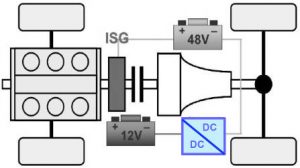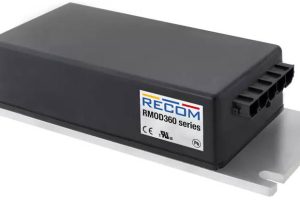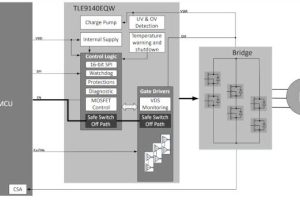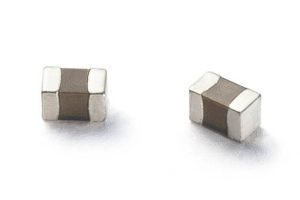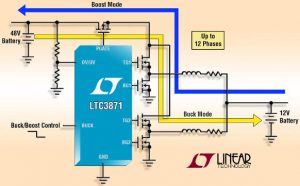
“12V automotive systems are reaching their 3kW power limit due to the ever-increasing demand for more electrical devices. A proposed standard, LV148, combines a secondary 48V bus with the existing 12V system,” said the firm. “The 48V rail includes a starter-generator, a 48V lithium-ion battery and a bi-directional DC/DC converter.”
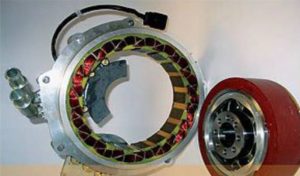 Starter-generators are either ‘integrated’ (ISGs) or connected by a belt (BSGs), charging of the 12V battery is via the dc-dc converter, and the result is a system that can deliver up to 10kW from the 48V and 12V batteries combined.
Starter-generators are either ‘integrated’ (ISGs) or connected by a belt (BSGs), charging of the 12V battery is via the dc-dc converter, and the result is a system that can deliver up to 10kW from the 48V and 12V batteries combined.
“Running a portion of a vehicle’s electrical system at 48V will play a central role in increasing available energy, while reducing wiring harness weight and losses,” Linear Tech v-p of power management Don Paulus.
Typically, the 12V bus will continue to power the ignition, lighting, infotainment and audio systems, according to Linear, while the 48V bus will supply active chassis systems, power steering, air conditioning compressors, electric superchargers/turbos and support regenerative braking, said Linear. When starting the car, or when additional power is required, the dc-dc converter allows both batteries supply energy simultaneously to either bus.
Such systems are aimed at conventional cars, as well as hybrid electric and ‘mild hybrid’ vehicles.
Mild hybrids have a single electrical machine motor/generator which does the job of the car’s alternator as well as providing some mechanical assistance to drive train so the engine can be turned off during coasting, braking, or when stopped, and provide a fast engine start for pulling away. They do not have an electric-only propulsion mode. Some fuel economy is gained over a conventional car, but not as much as with a full hybrid.
The Linear Tech chip, the LTC3871, a is a two-phase bi-directional dc-dc converter intended to operate in buck mode from the 48V bus to the 12V bus or in boost mode from 12V to 48V. Direction is set by a logic level on a pin.
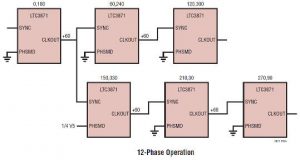 Multiple chips, up to 12 phases, can be paralleled and clocked out-of-phase to minimise input and output filtering for applications up to 250A). Two, three (two chip), four (two chip), six (three chip) eight (four chip) and 12-phase (six chip) systems are possible by various connections of three pins (Sync, ClkOut and PhsMd) on each chip.
Multiple chips, up to 12 phases, can be paralleled and clocked out-of-phase to minimise input and output filtering for applications up to 250A). Two, three (two chip), four (two chip), six (three chip) eight (four chip) and 12-phase (six chip) systems are possible by various connections of three pins (Sync, ClkOut and PhsMd) on each chip.
“Its advanced current-mode architecture provides excellent current matching between phases when paralleled. Up to 3kW can be supplied in buck mode or in boost mode with a 12-phase design,” said Linear.
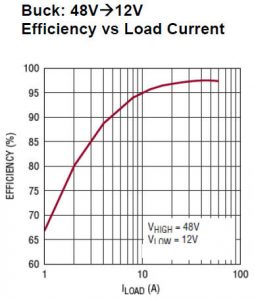 Up to 97% efficiency can be achieved and an on-chip current programming loop regulates the maximum current that can be delivered in either direction. Four control loops, two for current and two for voltage, enable control of voltage and current on both busses, with – Linear Tech has gone the extra mile here – independent loop compensation for buck and boost. Voltage regulation is to ±1% over temperature.
Up to 97% efficiency can be achieved and an on-chip current programming loop regulates the maximum current that can be delivered in either direction. Four control loops, two for current and two for voltage, enable control of voltage and current on both busses, with – Linear Tech has gone the extra mile here – independent loop compensation for buck and boost. Voltage regulation is to ±1% over temperature.
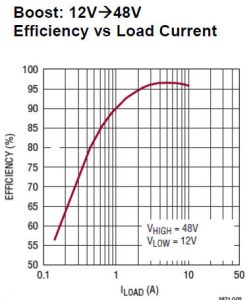 Operation is at a selectable fixed frequency across 60-460kHz, and can be synchronized to an external clock over the same range.
Operation is at a selectable fixed frequency across 60-460kHz, and can be synchronized to an external clock over the same range.
At light loads the user can select either continuous or pulse-skipping operation, and there is protection from over-loads and short-circuits as well as under-voltage and over-voltage lockout.
Tough for cars
“LTC3871 has been qualified to meet AEC-Q100 specifications and was designed with intrinsic safety being fully considered in line with the ISO-26262 standard,” said Linear Tech.
It comes in a thermally-enhanced 48 lead LQFP package and three grades are available with temperature ranges of -40 to 125°C for extended and industrial grades, and -40 to 150°C for automotive.
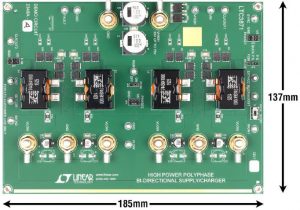 There is a four-phase demo board (pictured) which can achieve 97% efficiency in both directions (see graphs).
There is a four-phase demo board (pictured) which can achieve 97% efficiency in both directions (see graphs).
LTC3871 at a glance
- Buck or boost on demand
- Regulation of Vin, Vout or current
- ’48V’ rail up to 100V
- ’12V’ rail up to 30V
- AEC-Q100 complaint
- /ISO-26262 complaint
- Up to 12 phases (with 6 chips)
- Synchronous (up to 97% efficient)
- Current-mode control
- ±1% reference over temperature
- 60-460kHz operation, phase-lockable
- Over-load protection
- Short-circuit Protection
- 48-lead thermal LQFP
 Electronics Weekly Electronics Design & Components Tech News
Electronics Weekly Electronics Design & Components Tech News
